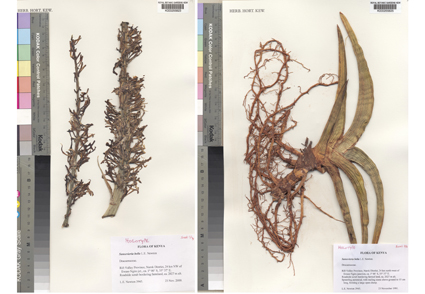Abstract
N/A
References
APG IV [Angiosperm Phylogeny Group] (2016) An update of the Angiosperm Phylogeny Group classification for the orders and families of flowering plants: APG IV. Botanical Journal of the Linnean Society 181: 1–20. https://doi.org/10.1111/boj.12385
Bogler, D.J. & Simpson, B.B. (1996) Phylogeny of Agavaceae based on ITS rDNA sequence variation. American Journal of Botany 83: 1225–1235. https://doi.org/10.1002/j.1537-2197.1996.tb13903.x
Bos, J.J. (1984) Dracaena in West Africa. Agricultural University Wageningen Papers 84: 1–125.
Bos, J.J. (1998) Dracaenaceae. In: Kubitzki, K. (Ed.) The families and genera of vascular plants 3. Springer-Verlag, Berlin, pp. 238–241. https://doi.org/10.1007/978-3-662-03533-7_30
Byng, J.W. & Christenhusz, J.M.M. (2018) Asparagaceae. In: Christenhusz, J.M.M., Fay, F.M. & Byng, J.W. (Eds.) The Global Flora. A practical flora to vascular plant species of the world. Special Edition. GLOVAP Nomenclature 1 (4). Gateway Ltd., Bradford, pp. 64–67.
Chen, S., Kim, D.K., Chase, M.W. & Kim, J.H. (2013) Networks in a large-scale phylogenetic analysis: Reconstructing evolutionary history of Asparagales (Lilianae) based on four plastid genes. PLoS ONE 8: e59472. https://doi.org/10.1371/journal.pone.0059472
Govaerts, R., Zonneveld, B.J.M. [2007, Hosta] & Zona, S.A. [2006, FTG] (2021) World Checklist of Asparagaceae. Facilitated by the Royal Botanic Gardens, Kew. Published on the Internet: http://wcsp.science.kew.org/ (accessed March 3 2021)
Kim, J., Kim, D., Fay, M.F. & Chase, M.W. (2010) Molecular phylogenetics of Ruscaceae sensu lato and related families (Asparagales) based on plastid and nuclear DNA sequences. Annals of Botany 106: 775–790. https://doi.org/10.1093/aob/mcq167
Linnaeus, C. (1767) Mantissa Plantarum II, Pars I Altera. Laurentii Salvii: Holmiae [Stockholm], 142 pp.
Lu, P.-L. & Morden, C.W. (2014) Phylogenetic relationships among dracaenoid genera (Asparagaceae: Nolinoideae) inferred from chloroplast DNA loci. Systematic Botany 39: 90–104. https://doi.org/10.1600/036364414X678035
Mabberley, D.J. (2017) Mabberley’s plant-book: a portable dictionary of plants, their classifications and uses. Ed. 4. Cambridge University Press, Cambridge, 1102 pp. https://doi.org/10.1017/9781316335581
Micarelli, S. (2020) The presence of Sansevieria bella in central Tanzania. Sansevieria 42: 8–13.
Moore, T. (1875) Mr. Will’s new dracaenas. Gardeners’ Chronicle n.s.: 615–616.
Newton, L.E. (2000) A beautiful new species of Sansevieria (Dracaenaceae) in Kenya. Cactus and Succulent Journal 72: 224–226.
Reveal, J.L. (2012) A divulgation of ignored or forgotten binomials. Phytoneuron 28: 1–64.
Salisbury, R.A.M. (1796) Prodromus Stirpium in Horto ad Chapel Allerton vigentium 245. [sine edit.]: Londini [London]. https://doi.org/10.5962/bhl.title.427
Takawira-Nyenya, R., Mucina, L., Cardinal-Mcteague, W.M., Thiele, K.R. (2018) Sansevieria (Asparagaceae, Nolinoideae) is a herbaceous clade within Dracaena: inference from non-coding plastid and nuclear DNA sequence data. Phytotaxa 376: 254–276. https://doi.org/10.11646/phytotaxa.376.6.2
Thunberg, C.P. (1794) Prodromus plantarum capensium 1. Johann Edman, Upsaliae [Uppsala]. 578 pp.
Turland, N.J., Wiersema, J.H., Barrie, F.R., Greuter, W., Hawksworth, D.L., Herendeen, P.S., Knapp, S., Kusber, W.-H., Li, D.-Z., Marhold, K., May, T.W., McNeill, J., Monro, A.M., Prado, J., Price, M.J., Smith, G.F., 2018. International Code of Nomenclature for algae, fungi, and plants (Shenzhen Code) adopted by the Nineteenth International Botanical Congress Shenzhen, China, July 2017. Regnum Vegetabile 159: 1–254. https://doi.org/10.12705/Code.2018
Zhou,Y.-D., Liu, B., Mbuni, Y., Yan, X., Mwachala, G., Hu, G.-W. & Wang, Q.-F. (2017) Vascular flora of Kenya, based on the Flora of Tropical East Africa. PhytoKeys 90: 113–126. https://dx.doi.org/10.3897/phytokeys.90.20531
Bogler, D.J. & Simpson, B.B. (1996) Phylogeny of Agavaceae based on ITS rDNA sequence variation. American Journal of Botany 83: 1225–1235. https://doi.org/10.1002/j.1537-2197.1996.tb13903.x
Bos, J.J. (1984) Dracaena in West Africa. Agricultural University Wageningen Papers 84: 1–125.
Bos, J.J. (1998) Dracaenaceae. In: Kubitzki, K. (Ed.) The families and genera of vascular plants 3. Springer-Verlag, Berlin, pp. 238–241. https://doi.org/10.1007/978-3-662-03533-7_30
Byng, J.W. & Christenhusz, J.M.M. (2018) Asparagaceae. In: Christenhusz, J.M.M., Fay, F.M. & Byng, J.W. (Eds.) The Global Flora. A practical flora to vascular plant species of the world. Special Edition. GLOVAP Nomenclature 1 (4). Gateway Ltd., Bradford, pp. 64–67.
Chen, S., Kim, D.K., Chase, M.W. & Kim, J.H. (2013) Networks in a large-scale phylogenetic analysis: Reconstructing evolutionary history of Asparagales (Lilianae) based on four plastid genes. PLoS ONE 8: e59472. https://doi.org/10.1371/journal.pone.0059472
Govaerts, R., Zonneveld, B.J.M. [2007, Hosta] & Zona, S.A. [2006, FTG] (2021) World Checklist of Asparagaceae. Facilitated by the Royal Botanic Gardens, Kew. Published on the Internet: http://wcsp.science.kew.org/ (accessed March 3 2021)
Kim, J., Kim, D., Fay, M.F. & Chase, M.W. (2010) Molecular phylogenetics of Ruscaceae sensu lato and related families (Asparagales) based on plastid and nuclear DNA sequences. Annals of Botany 106: 775–790. https://doi.org/10.1093/aob/mcq167
Linnaeus, C. (1767) Mantissa Plantarum II, Pars I Altera. Laurentii Salvii: Holmiae [Stockholm], 142 pp.
Lu, P.-L. & Morden, C.W. (2014) Phylogenetic relationships among dracaenoid genera (Asparagaceae: Nolinoideae) inferred from chloroplast DNA loci. Systematic Botany 39: 90–104. https://doi.org/10.1600/036364414X678035
Mabberley, D.J. (2017) Mabberley’s plant-book: a portable dictionary of plants, their classifications and uses. Ed. 4. Cambridge University Press, Cambridge, 1102 pp. https://doi.org/10.1017/9781316335581
Micarelli, S. (2020) The presence of Sansevieria bella in central Tanzania. Sansevieria 42: 8–13.
Moore, T. (1875) Mr. Will’s new dracaenas. Gardeners’ Chronicle n.s.: 615–616.
Newton, L.E. (2000) A beautiful new species of Sansevieria (Dracaenaceae) in Kenya. Cactus and Succulent Journal 72: 224–226.
Reveal, J.L. (2012) A divulgation of ignored or forgotten binomials. Phytoneuron 28: 1–64.
Salisbury, R.A.M. (1796) Prodromus Stirpium in Horto ad Chapel Allerton vigentium 245. [sine edit.]: Londini [London]. https://doi.org/10.5962/bhl.title.427
Takawira-Nyenya, R., Mucina, L., Cardinal-Mcteague, W.M., Thiele, K.R. (2018) Sansevieria (Asparagaceae, Nolinoideae) is a herbaceous clade within Dracaena: inference from non-coding plastid and nuclear DNA sequence data. Phytotaxa 376: 254–276. https://doi.org/10.11646/phytotaxa.376.6.2
Thunberg, C.P. (1794) Prodromus plantarum capensium 1. Johann Edman, Upsaliae [Uppsala]. 578 pp.
Turland, N.J., Wiersema, J.H., Barrie, F.R., Greuter, W., Hawksworth, D.L., Herendeen, P.S., Knapp, S., Kusber, W.-H., Li, D.-Z., Marhold, K., May, T.W., McNeill, J., Monro, A.M., Prado, J., Price, M.J., Smith, G.F., 2018. International Code of Nomenclature for algae, fungi, and plants (Shenzhen Code) adopted by the Nineteenth International Botanical Congress Shenzhen, China, July 2017. Regnum Vegetabile 159: 1–254. https://doi.org/10.12705/Code.2018
Zhou,Y.-D., Liu, B., Mbuni, Y., Yan, X., Mwachala, G., Hu, G.-W. & Wang, Q.-F. (2017) Vascular flora of Kenya, based on the Flora of Tropical East Africa. PhytoKeys 90: 113–126. https://dx.doi.org/10.3897/phytokeys.90.20531


